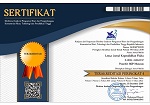PENGGUNAAN MODEL CONTEXTUAL TEACHING AND LEARNING (CTL) SEBAGAI UPAYA UNTUK MENINGKATKAN MINAT DAN KEMAMPUAN PEMAHAMAN KONSEP GARIS DAN SUDUT PADA SISWA KELAS VII MTS. PUTRA NURUL HAKIM KEDIRI TAHUN PELAJARAN 2012/2013
DOI:
https://doi.org/10.33394/j-lkf.v1i1.75Keywords:
Contextual Teaching and Learnig, interests, understanding of concepts, lines and anglesAbstract
The mathematics lesson in class VII MTs Putra Nurul Hakim Kediri is less desirable by the students. Therefore, their understanding of mathematical concepts is lacking. This study aims to apply Contextual Teaching and Learning (CTL) model to improve students' interest and understanding ability. The results showed that, the evaluation of cycles I and II, the percentage of classical completeness are: 66.66% and 87.87%. Teacher activity is good in cycle I and II. Students' math learning interest is very high in cycle II. The results of this study indicate an increase in interest and ability to understand students' concepts. We conclude that the Contextual Teaching and Learning (CTL) model proves to increase students' interest in and understanding of concepts.
Â
References
Aunurrahman. (2011). Belajar dan Pembelajaran. Bandung: Alfabeta
Faisal, M. (2009). Penerapan Pembelajaran Kontekstual untuk Meningkatkan Prestasi Belajar Siswa Kelas X SMA Trisakti Mataram Tahun Pelajaran 2008/2009. Skripsi. IKIP Mataram.
Hamalik, O. (2010). Perencanaan Pengajaran Berdasarkan Pendekatan Sistem. Jakarta: Bumi Aksara
Hamalik, O. (2005). Proses Belajar Mengajar. Jakarta: Bumi Aksara
Mudjiono. (2010). Belajar dan Pembelajaran. Jakarta: Rineka Cipta
Nasution, S. (2007). Metode Research. Jakarta: Bumi Aksara
Sa’ud, Syaefudin Udin. (2011). Inovasi Pendidikan. Bandung: Alfabeta
Slameto. (2010). Belajar dan Faktor-faktor yang Mempengaruhi. Jakarta: Rineka Cipta
Sujatmico Konco. (2005). Matematika Kreatif Konsep dan Terapannya: untuk Kelas VII SMP dan MTs. Solo: Tiga Serangkai Pustaka Mandiri
Sumarno, U. (2010). Berpikir dan Disposisi Matematik: Apa, Mengapa, dan Bagaimana dikembangkan pada Peserta Didik. Jurnal. FPMIPA UPI.
Syahrir. (2010). Metodologi Pembelajaran Matematika. Yogyakarta: Naufan Pustaka.
Wahidmurni. (2009). Penelitian Tindakan Kelas dari Teori Menuju Praktik. Malang: UM Press
Downloads
Published
How to Cite
Issue
Section
Citation Check
License
Authors who publish with Lensa: Jurnal Kependidikan Fisika agree to the following terms:
- For all articles published in Lensa: Jurnal Kependidikan Fisika, copyright is retained by the authors. Authors give permission to the publisher to announce the work with conditions. When the manuscript is accepted for publication, the authors agree to automatic transfer of the publishing right to the publisher.
- Authors retain copyright and grant the journal right of first publication with the work simultaneously licensed under a Creative Commons Attribution-ShareAlike 4.0 International License that allows others to share the work with an acknowledgment of the work's authorship and initial publication in this journal.
- Authors are able to enter into separate, additional contractual arrangements for the non-exclusive distribution of the journal's published version of the work (e.g., post it to an institutional repository or publish it in a book), with an acknowledgment of its initial publication in this journal.
- Authors are permitted and encouraged to post their work online (e.g., in institutional repositories or on their website) prior to and during the submission process, as it can lead to productive exchanges, as well as earlier and greater citation of published work (See The Effect of Open Access).

This work is licensed under a Creative Commons Attribution-ShareAlike 4.0 International License.

.png)

